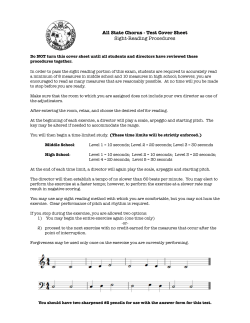
Ataxia and Speech Jennifer Legge M.S., CCC-SLP University of Chicago Medical
Ataxia and Speech Jennifer Legge M.S., CCC-SLP University of Chicago Medical Speech and Swallowing Department Understanding the process of Speech Production • • • • • • • 1.Anatomy-Figure 1 2.Respiratory System 3.Phonatory System 4.Articulatory System 5.Resonatory System 6.Auditory Feedback 7.Cerebellum Anatomy-Figure 1 • http://english.marion.ohio-state.edu/behan/English271/midsagittal.jpg Respiratory System • Lungs to the larynx • The power behind out speech • Coordination of the respiratory system (lungs to the larynx) • Good respiratory support is key • Timed release of air to support each word Phonatory System • Larynx specifically the vocal cords • Vocal cords vibrate when air passes through them…producing a sound • (E.x., /me/, feel your throat) Articulatory System • Mouth including jaw, lips, teeth, tongue, and the palate • Movement of the air passes through the mouth and where movements of the articulators modify the sound producing different vowels and consonants • (e.g., /l/, /m/, /k/) Resonatory System • Mouth and nasal passages Auditory Feedback • Discriminate one sound from another • Monitor speech to make it more precise • (e.g., deaf speech) Cerebellum • Tunes impulses coming in from brain for any motor task…(i.e.,speech) • Coordinates and refines planned motor impulses, and modifies planned and ongoing speech movements • • • • coordination timing measuring movement size planning and incorporating feedback How does ataxia effect ones speech? 1.Respiration-decreased breath support, reduced coordination of breath/speech leading to excessive or paradoxical movements. Speaking on residual air…what happens? 1) increased rate, decreased volume, and hash voice 2.Phonation- harsh vocal quality due to decreased muscle tone 3.Articulation-decreased oral tone, oral coordination, irregular break downs ,distorted vowels, prolonged phonemes, 4.Resonation-seldomly a problem 5.Prosody-equal and excess stress ,problems with motor learning, mono pitch, mono loudness Ataxic Dysarthria • Speech characterized by “drunkenness”, imprecise consonants and vowels, slurred, distorted, irregular breakdown, excess and equal stress, slow rate of speech, mono pitch and mono loudness, may display explosive speech with poor control of pitch and loudness Evaluation and Treatment • Evaluation by an SLP • Treatment – 1. Exercises • Oromotor exercises targeting strengthening muscles (e.g., pucker/smile • Improving breath support, and coordinating breathing and speaking • Increasing or controlling volume (e.g., Lee Silverman) • Consonant/vowel drills, rate drills, over articulation practice • Word, phrase, and sentence stress ( TODAY is a GREAT day!) • Pitch control (e.g., How are you?) Compensatory Strategies for the Speaker • Attempt to have conversations when you are not tired • Minimize distractions • Have your listeners undivided attention • Decrease rate of speech, feels slow ALREADY! • Focus on getting your point across utilize less words, sentences. • Use gestures when indicated • Prep your listener if need be Advice for loved ones, or the listener • • • • • Eye contact is crucial Undivided attention Be patient Seek clarification Provide support, encourage use of strategies Communication Aids • Communication Board • Computer-new software out there? • Augmentative device, seek out an experienced speech language pathologist to help you explore your options What works, what doesn’t, what is new? • 1. Specific Questions • 2. What has worked for you, hasn’t? • 3. How many of you have had some type of speech therapy? If so was it helpful? If not why? • 4. Try more than one therapist? • 5. Best advice anyone gave you? References • • • • Kent, R.D, Finley Kent, J, Duffy, J, Thomas, J, Weismer, G, Stuntebeck, S (2000). Ataxic Dysarthria. Journal of Speech, Language, and Hearing Research, 1275-1287. Rangamani, G.N., J. (2006). Managing Speech and Swallowing Problems: A Guidebook for People with Ataxia. National Ataxia Foundation, 1-60. Retrieved February 21, 2009, from Speech-Therapy-On-Video website: http://www.speech-therapyonvideo.com/dysarthria.html Retrieved February 21, 2009, from Asha.org website: http://www.asha.org/public/speech/disorders/dysarthria.htm#dys _tx Contact Information Jennifer Legge M.S., CCC-SLP 773-795-2579 jennifer.legge@uchospitals.edu
© Copyright 2025





















